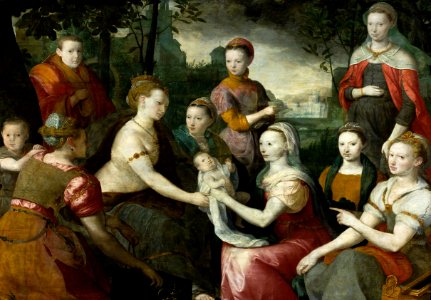Bernaert de rickere, a flemish artist whose work shows affinities with the works of frans floris and maerten de vos, staged this group portrait as the biblical event of the finding of moses by the pharaoh's daughter (exodus 2:5-6). Cyprian lachnicki (in 1876-1906, honorary director of the museum of fine arts - the predecessor of the national museum), from whose generous bequest this extraordinary work comes, linked its authorship with françois clouet and put forward (following the french historian louis vitet) an interesting hypothesis regarding the allegorical content hidden in it. Well, the "daughter of the pharaoh" (among the women dressed in the fashion of the 1560s, the only woman partially covering her nudity, decked in jewels) was diana of poitiers, duchess of valentinois, the favorite of king henry ii of france, who, according to records, was supposed to take great care of the sickly royal children. An example of an egyptian princess who gave the found baby moses to a nurse, diana of poitiers entrusts the youngest descendant of henry ii, the newborn prince d'alençon, to the care of a nurse of her choice. This hypothesis is not unfounded, because the jewels depicted in the painting of the ladies feature authentic symbols (so-called "numbers") of diana of poitiers, and the figures of the two boys shown on the left side of the composition are similar to the portrait drawings of the young valois (later francis ii and charles ix) preserved in the louvre. However, when the painting indicated by its stylistic features was created (1560s), the boys would have been over 10 years older. The italianism of this performance, filtered through the outstanding features of the so-called french court art. Of the fontainebleau school, manifests itself in the depiction of the main figure of the pharaoh's daughter / diana of poitiers in the costume of an ancient goddess rather than a biblical figure, and in the motif of a woman with her back turned on the left side of the composition, borrowed from tintoretto's painting. K. Secomska (unpublished report 1967) was the first to draw attention to the analogies of the painting with the paintings of bernaert de rijckere. In 1970, j. Ollero published an attribution, which he based on the signed work of bernaert de rijckere, the four evangelists, in the church of san marcos in madrid. Ultimately, the attribution was confirmed by the appearance on the vienna art market of a signed and dated (1562) version of the warsaw painting (kreidl 1979). A preparatory drawing for this composition and a separate sketch for the figure of the older boy in the warsaw painting are preserved in the louvre. Due to the fact that there is another (anonymous) flemish finding of moses in the museum in orleans with some formal similarities, it has been suggested that this topic in franco-flemish art could be treated metaphorically and illustrate the fact of a child being taken into the care of a powerful lady from a noble family. [hanna benesz]. Object Type: painting. Genre: religious art. Date: circa 1556. Dimensions: height: 114.5 cm (45 in); width: 169 cm (66.5 in). Medium: oil on panel. Depicted People: Moses. Collection: National Museum in Warsaw. Rijckere Moses saved from the waters
Loading...
